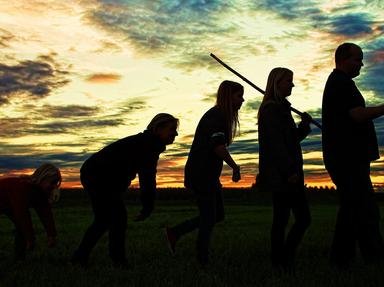Quiz Answer Key and Fun Facts
1. The work of professor John Endler in Venezuela and Trinidad showed how guppies in separate lakes/streams, with different selective pressures, become gradually different, eventually leading to sexual segregation. What is this phenomenon called?
2. Artificial selection has been practiced by humans for thousands of years and works on the same principles as natural selection. Which of these is not an example of artificial selection?
3. When two populations are separated, speciation can occur. If these species then come together once more, they may produce hybrids. The fitness of these hybrids determines whether or not the two species will merge to become one species. What term is used for the areas where hybrids can be found, such as that found in Eastern Europe formed from the interbreeding of yellow-bellied and fire-bellied toads?
4. Sexual selection is a strong driving force for evolution within a species. The results can be dramatic, making males and females of the same species appear drastically different. What name is given to this phenomenon, which operates strongly on peafowl and sperm whales?
5. It is a peculiar fact that humans, the most complex organisms on Earth, have a genome that is less than a fifth of the size the genome of wheat. One leading explanation behind this is that the wheat genome has had more time to evolve, during which time it has accumulated a large amount of non-functioning (or "junk") DNA. What term is used to describe the fact that genome size is not an indicator of organismal complexity?
6. Unlike the idea of intelligent design, evolution modifies existing traits/structures rather than creating new ones from nowhere. An example of this is the laryngeal nerve in mammals, which arose first in our fish-like ancestors. This structure connects the brain to the larynx, but first loops around the aorta, unnecessarily lengthening its journey by several metres in some mammals. What is this by-product of evolution known as?
7. The sheer amount of time required for most species to undergo significant evolution so as to be appreciated by the human eye is a huge factor for the late arrival of Darwin's theory of evolution by natural selection. The discovery of penicillin in 1928 allowed evolution in microorganisms to occur on a scale that allowed it to be observed in a human lifetime. Which of these is not a reason for the more rapid evolution of microorganisms (compared to that of animals)?
8. As mentioned previously, sexual selection is a strong driving force of evolution and is responsible for some of the most eye-catching animals on our planet. If in optimal conditions, sexually reproducing animals could experience a situation where they become more and more physically impressive, but this is often prevented by predation. What is the name of this phenomenon?
9. The rarity of fossils have often been used by creationists to contradict the idea of evolution, yet those which do exist often tell clear stories about the natural history of living organisms. Certain fossils, like the famous Archaeopteryx, are labelled "missing links". Whilst Archaeopteryx helps to bridge the gap between reptiles and the appearance of birds, what transition is the animal "Tiktaalik" said to represent?
10. Despite diverging around 125 million years ago, many groups of marsupials and placental mammals are physically similar. For example, flying squirrels (a placental mammal) is uncannily similar to the marsupial sugar glider, which has been isolated on Australia since the break-up of Gondwana. What name is given to this phenomenon, which results from two species evolving independently of one another, but in similar environmental conditions?
Source: Author
doublemm
This quiz was reviewed by FunTrivia editor
gtho4 before going online.
Any errors found in FunTrivia content are routinely corrected through our feedback system.
